check engine light CADILLAC DEVILLE 1998 7.G User Guide
[x] Cancel search | Manufacturer: CADILLAC, Model Year: 1998, Model line: DEVILLE, Model: CADILLAC DEVILLE 1998 7.GPages: 386, PDF Size: 22.36 MB
Page 155 of 386
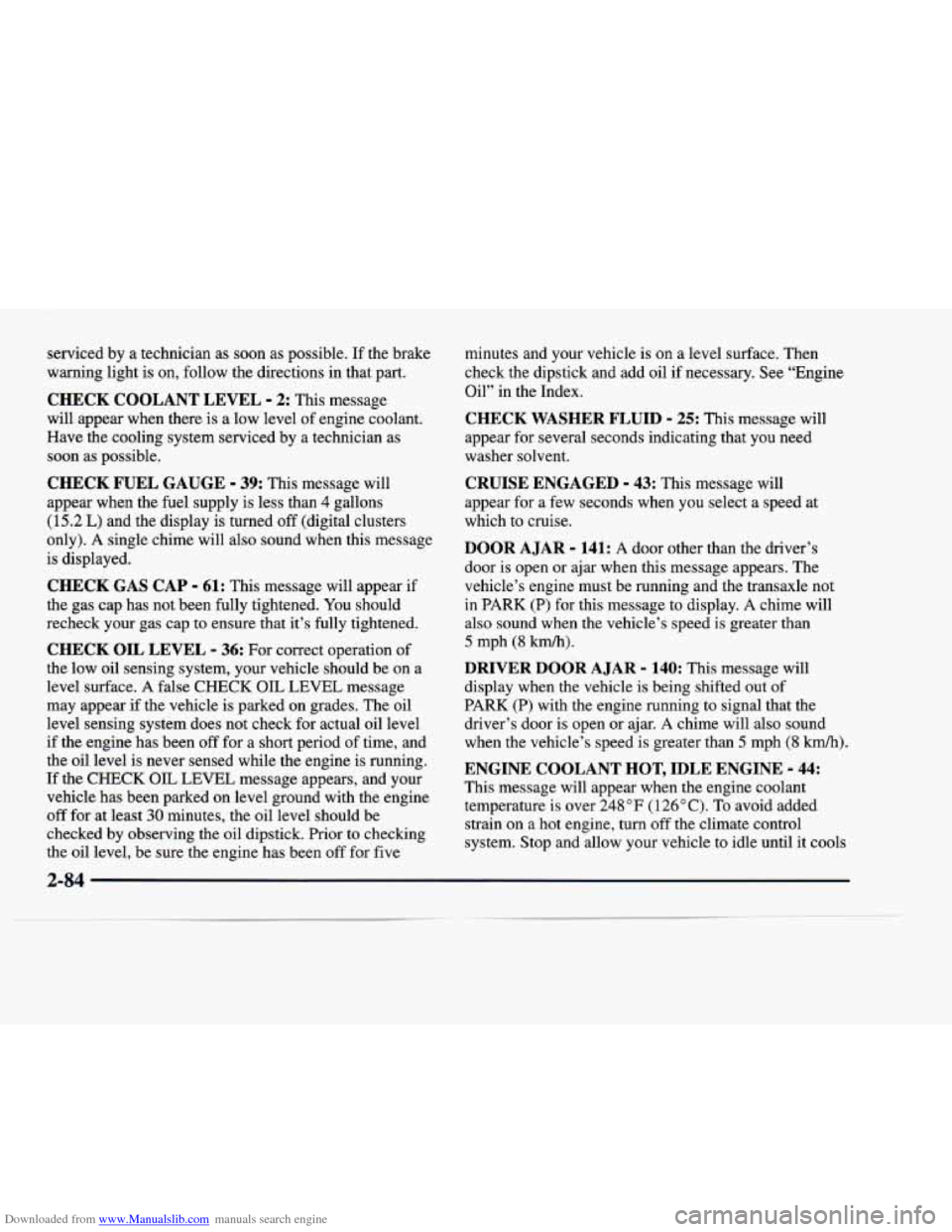
Downloaded from www.Manualslib.com manuals search engine serviced by a technician as soon as possible. If the brake
warning light is on, follow the directions in that part.
CHECK COOLANT LEVEL - 2: This message
will appear when there is a low level of engine coolant.
Have the cooling system serviced by a technician as
soon as possible.
CHECK FUEL GAUGE - 39: This message will
appear when the
fuel supply is less than 4 gallons
(15.2 L) and the display is turned off (digital clusters
only).
A single chime will also sound when this message
is displayed.
CHECK GAS CAP - 61: This message will appear if
the gas cap has not been fully tightened.
You should
recheck your gas cap to ensure that it’s fully tightened.
CHECK OIL LEVEL - 36: For correct operation of
the low oil sensing system, your vehicle should be on a
level surface. A false
CHECK OIL LEVEL message
may appear if the vehicle is parked on grades. The oil
level sensing system does not check for actual oil level
if the engine has been off for a short period of time, and
the oil level is never sensed while the engine is running.
If the
CHECK OIL LEVEL message appears, and your
vehicle has been parked on level ground with the engine
off for at least 30 minutes, the oil level should be
checked by observing the oil dipstick. Prior to checking
the oil level, be sure the engine has been
off for five minutes and your vehicle is on a level surface. Then
check the dipstick and add oil if necessary. See “Engine
Oil’’
in the Index.
CHECK WASHER FLUID - 25: This message will
appear for several seconds indicating that
you need
washer solvent.
CRUISE ENGAGED - 43: This message will
appear for a few seconds when you select a speed at
which to cruise.
DOOR A JAR - 141: A door other than the driver’s
door is open or ajar when this message appears. The
vehicle’s engine must be running and the transaxle not
in PARK (P) for this message to display. A chime will
also sound when the vehicle’s speed
is greater than
5 mph (8 km/h).
DRIVER DOOR A JAR - 140: This message will
display when the vehicle is being shifted out of
PARK (P) with the engine running to signal that the
driver’s door is open or ajar.
A chime will also sound
when the vehicle’s speed is greater than
5 mph (8 km/h).
ENGINE COOLANT HOT, IDLE ENGINE - 44:
This message will appear when the engine coolant
temperature is over
248 “F (1 26 O C). To avoid added
strain on a hot engine, turn off the climate control
system. Stop and allow your vehicle to idle until it cools
2-84
Page 158 of 386
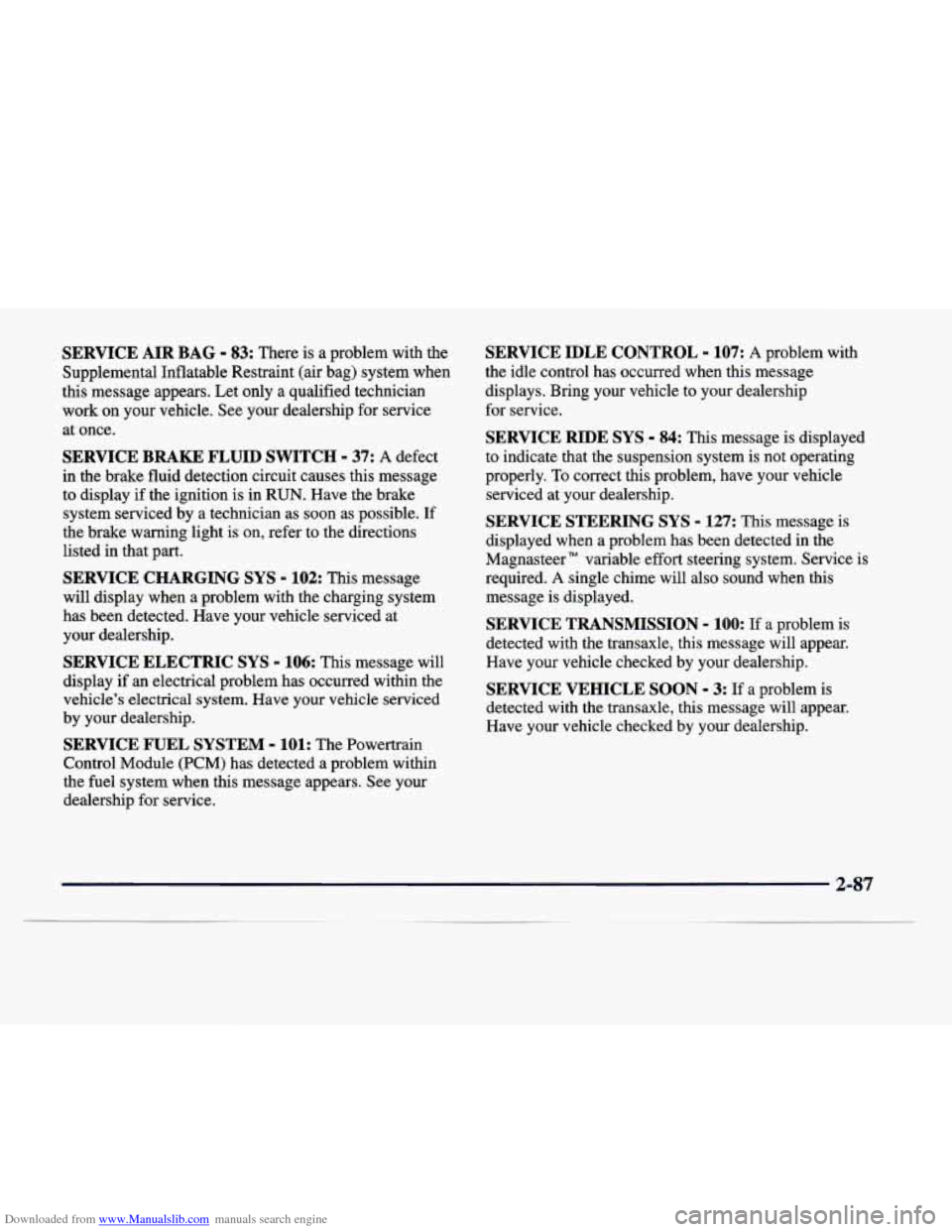
Downloaded from www.Manualslib.com manuals search engine SERVICE AIR BAG - 83: There is a problem with the
Supplemental Inflatable Restraint (air bag) system when
this message appears. Let only a qualified technician
work on your vehicle. See your dealership for service
at once.
SERVICE BRAKE FLUID SWITCH - 37: A defect
in the brake fluid detection circuit causes this message
to display if the ignition
is in RUN. Have the brake
system serviced by a technician as soon as possible.
If
the brake warning light is on, refer to the directions
listed in that part.
SERVICE CHARGING SYS - 102: This message
will display when a problem with the charging system
has been detected. Have your vehicle serviced at
your dealership.
SERVICE ELECTRIC SYS - 106: This message will
display
if an electrical problem has occurred within the
vehicle’s electrical system. Have your
vehicle serviced
by your dealership.
SERVICE FUEL SYSTEM - 101: The Powertrain
Control Module (PCM) has detected a problem within
the
fuel system when this message appears. See your
dealership for service.
SERVICE IDLE CONTROL - 107: A problem with
the idle control has occurred when this message
displays. Bring your vehicle to your dealership
for service.
SERVICE RIDE SYS - 84: This message is displayed
to indicate that the suspension system is not operating
properly. To correct this problem, have your vehicle serviced at your dealership.
SERVICE STEERING SYS - 127: This message is
displayed when a problem has been detected in the
Magnasteer” variable effort steering system. Service is
required.
A single chime will also sound when this
message is displayed.
SERVICE TRANSMISSION - 100: If a problem is
detected with the transaxle, this message will appear.
Have your vehicle checked by your dealership.
SERVICE VEHICLE SOON - 3: If a problem is
detected with the transaxle, this message will appear.
Have your vehicle checked by your dealership.
2-87
Page 206 of 386
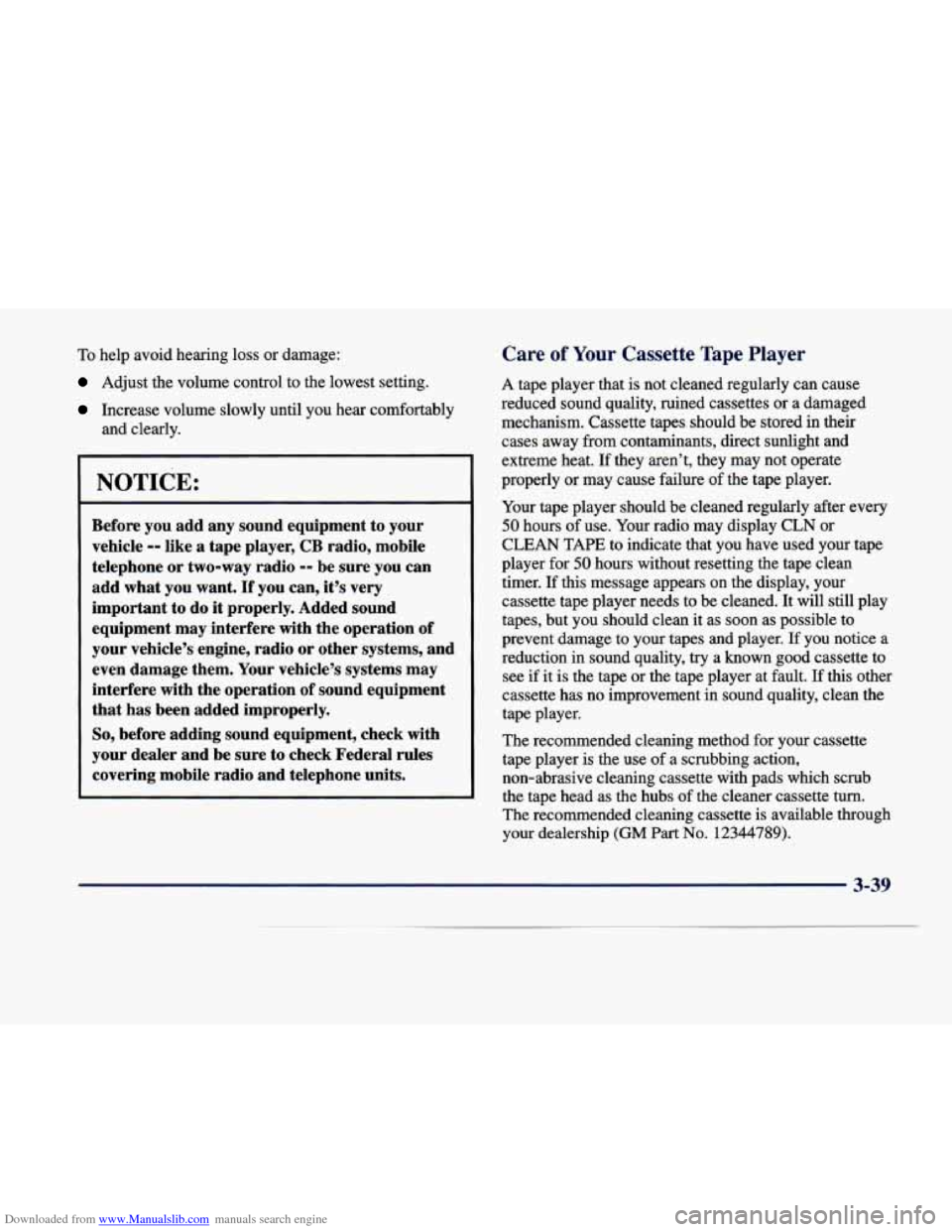
Downloaded from www.Manualslib.com manuals search engine To help avoid hearing loss or damage:
Adjust the volume control to the lowest setting.
Increase volume slowly until you hear comfortably
and clearly.
I NOTICE:
Before you add any sound equipment to your
vehicle
-9 like a tape player, CB radio, mobile
telephone or two-way radio
9- be sure you can
add what you want.
If you can, it’s very
important to do it properly. Added sound
equipment may interfere with the operation of
your vehicle’s engine, radio or other systems, and
even damage them. Your vehicle’s systems may
interfere with the operation
of sound equipment
that has been added improperly.
So, before adding sound equipment, check with
your dealer and be sure to check Federal rules
covering mobile radio and telephone units.
Care of Your Cassette Tape Player
A tape player that is not cleaned regularly can cause
reduced sound quality, ruined cassettes or a damaged
mechanism. Cassette tapes should be stored in their
cases away from contaminants, direct sunlight and
extreme heat.
If they aren’t, they may not operate
properly or may cause failure
of the tape player.
Your tape player should be cleaned regularly after every
50 hours of use. Your radio may display CLN or
CLEAN TAPE to indicate that you have used your tape
player for
50 hours without resetting the tape clean
timer.
If this message appears on the display, your
cassette tape player needs to be cleaned. It will still play
tapes, but you should clean it as soon as possible to
prevent damage to your tapes and player. If you notice a
reduction in sound quality,
try a known good cassette to
see if it is the tape or the tape player at fault.
If this other
cassette has no improvement
in sound quality, clean the
tape player.
The recommended cleaning method for your cassette
tape player is the use of a scrubbing action,
non-abrasive cleaning cassette with pads which scrub
the tape head
as the hubs of the cleaner cassette turn.
The recommended cleaning cassette is available through
your dealership
(GM Part No. 12344789).
3-39
Page 218 of 386
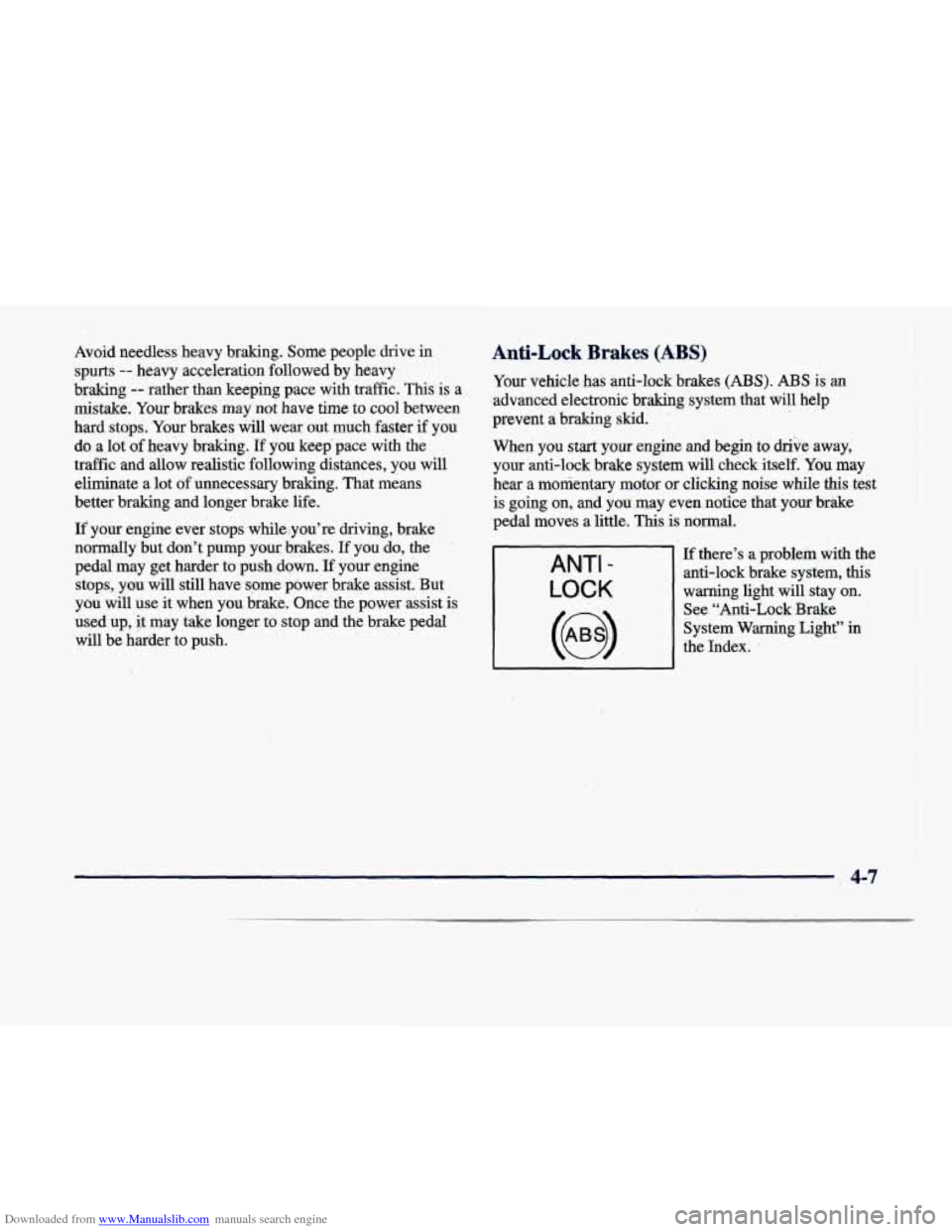
Downloaded from www.Manualslib.com manuals search engine Avoid needless’heavy braking. Some people drive in Anti-Lock Brakes (ABS)
spurts -- heavy acceleration followed by heavy
braking
-- rather than keeping pace with traffic.. This is a.
mistake. Your brakes may not have time to cool between
hard stops. ‘Your brakes will wear out much faster
if you Your
vehicle has anti-lock brakes
(ABS). ABS is an
,advanced electronic braking system that will help
prevent a braking skid.
do a lot of heavy braking.
If you keep pace with the
When you start your engine and begin to drive away,.
traffic and
allow realistic. following distances, you will
your anti-lock brake system will check itself. You may
eliminate a lot
of unnecessary braking. That means
hear a momentary motor or clicking noise while this test
better braking and longer brake life.
is going on, and you ‘may even notice that your brake
If your engine ever stops while,you’re driving, brake pedal moves a
little. This is normal.
no-&mlly but don’t pump your brakes.
If you do, the
pedal may get harder to push down.
If your engine
stops, you will still have some power brake assist. But
you will use it when you brake. Once the power assist is
used up,
it may take longer to stop and the brake pedal
will be harder to push.
ANTI -
LOCK
’ If there’s a problem with the
1 anti-lock brake system, this
warning light will stay on.
See “Anti-Lock Brake
System -Warning Light” in
the Index. ~
’( 4-7
Page 227 of 386
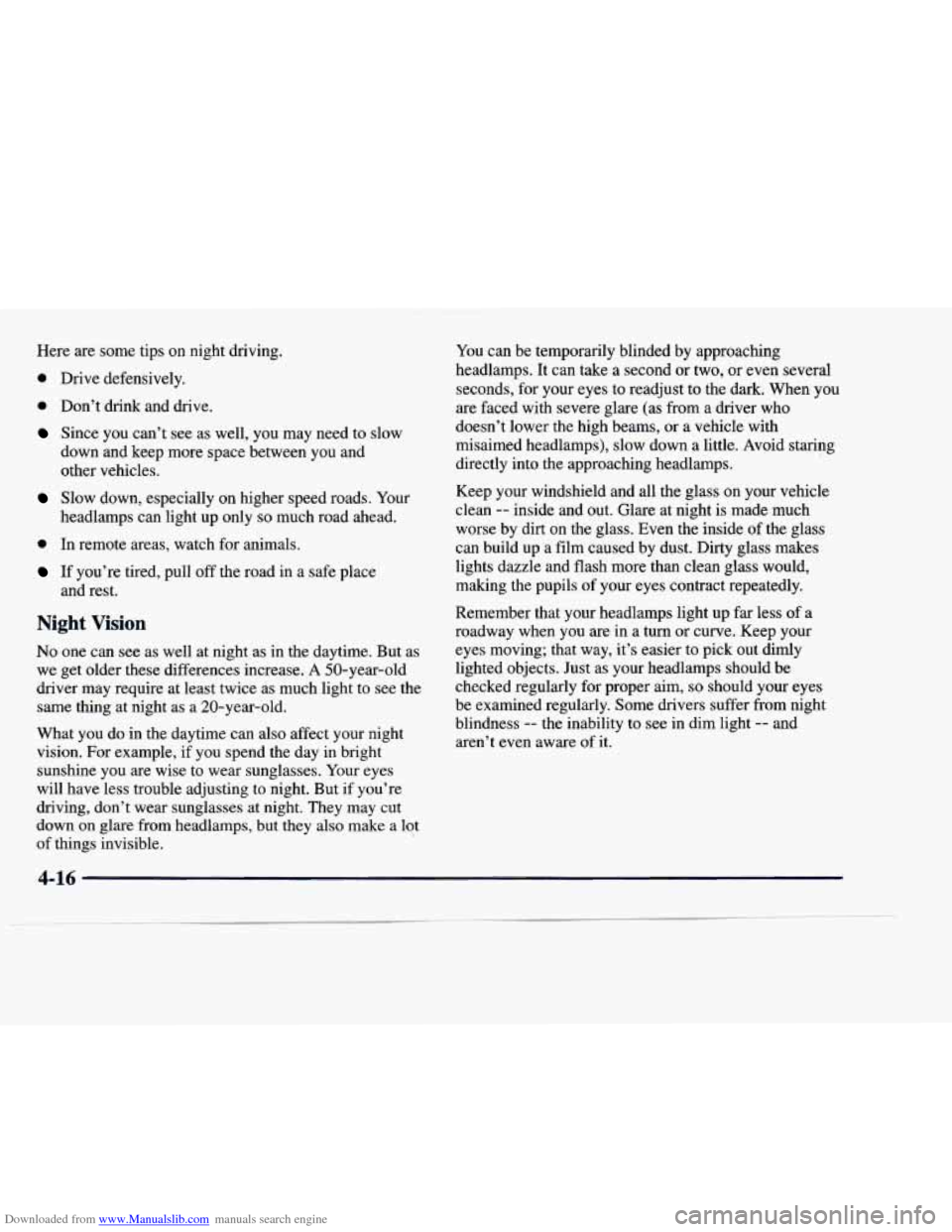
Downloaded from www.Manualslib.com manuals search engine Here are some tips on night driving.
0 Drive defensively.
0 Don’t drink and drive.
Since you can’t see as well, you may need to slow
down and keep more space between you and
other vehicles.
Slow down, especially on higher speed roads. Your
headlamps can light up only
so much road ahead.
0 In remote areas, watch for animals.
If you’re tired, pull off the road in a safe place
and rest.
Night Vision
No one can see as well at night as in the daytime. But as
we get older these differences increase.
A 50-year-old
driver may require at least twice as much light to see the
same thing at night as a 20-year-old.
What you do in the daytime can also affect your night
vision. For example, if you spend the day in bright
sunshine you are wise to wear sunglasses. Your eyes
will have less trouble adjusting to night. But if you’re
driving, don’t wear sunglasses at night. They may cut
down
on glare from headlamps, but they also make a lot
of things invisible. You
can be temporarily blinded by approaching
headlamps. It can take a second or two, or even several
seconds, for your eyes to readjust to the dark. When you
are faced with severe glare (as from a driver who
doesn’t lower the high beams, or a vehicle with
misaimed headlamps), slow down a little. Avoid staring
directly into the approaching headlamps.
Keep your windshield and all the glass on your vehicle
clean
-- inside and out. Glare at night is made much
worse by dirt on the glass. Even the inside of the glass
can build up a film caused by dust. Dirty glass makes
lights dazzle and flash more than clean glass would,
making the pupils of your eyes contract repeatedly.
Remember that your headlamps light up far less of a
roadway when you are in a turn or curve. Keep your
eyes moving; that way, it’s easier to pick out dimly
lighted objects. Just as your headlamps should be
checked regularly for proper aim,
so should your eyes
be examined regularly. Some drivers suffer from night
blindness
-- the inability to see in dim li,ght -- and
aren’t even aware of it.
4-16
Page 231 of 386
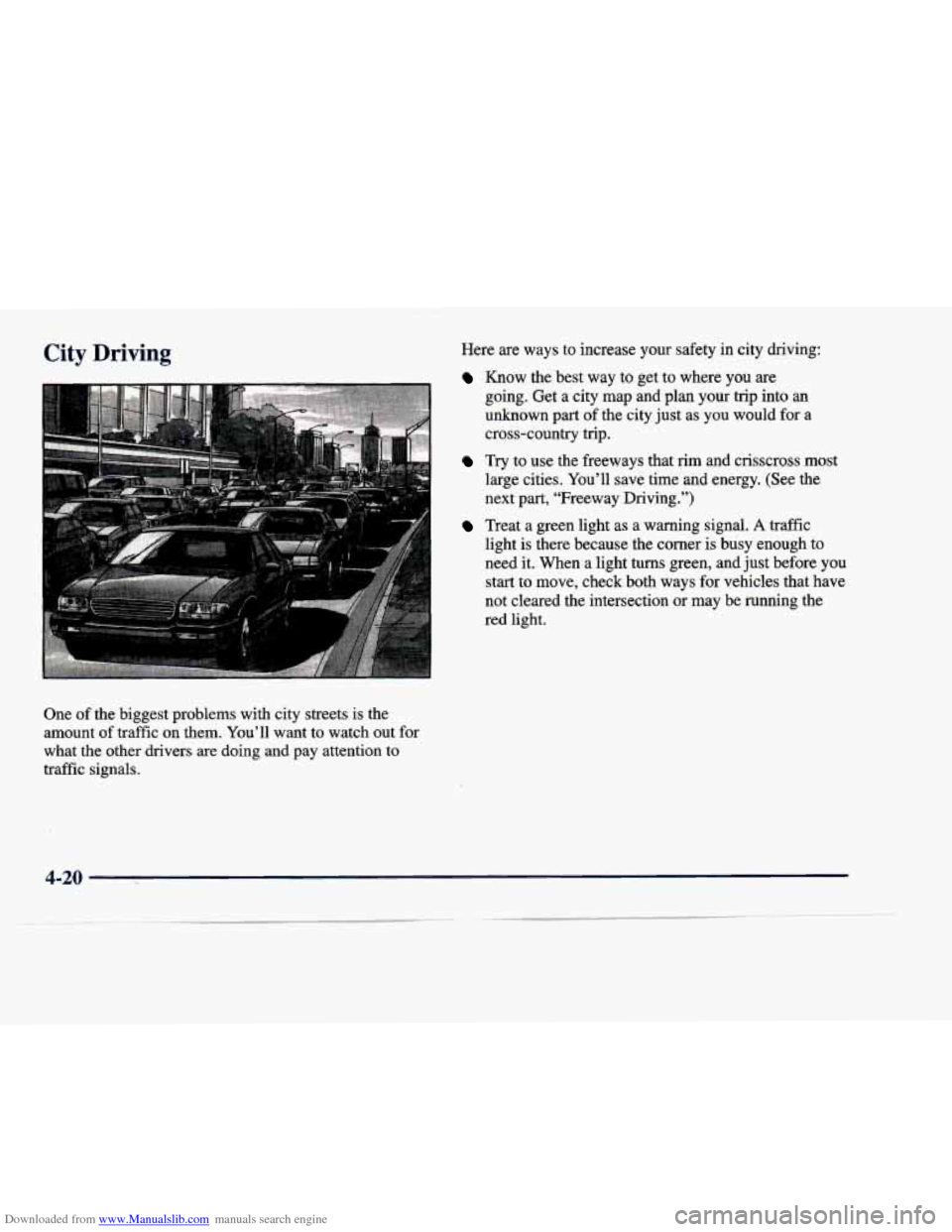
Downloaded from www.Manualslib.com manuals search engine City Driving Here are ways to increase your safety in city driving:
Know the best way to get to where you are
going. Get
a city map and plan your trip into an
unknown part of the city just as you would for a
cross-country trip.
Try to use the freeways that rim and crisscross most
large cities. You’ll save time and energy. (See the
next part, “Freeway Driving.”)
One
of the biggest problems with city streets is the
amount
of traffic on them. You’ll want to watch out for
what the other drivers are doing and pay attention to
traffic signals.
Treat a green light as a warning signal. A traffic
light is there because the comer is busy enough to
need it. When
a light turns green, and just before you
start to move, check both ways for vehicles that have
not cleared the intersection or may be running the
red light.
4-20
Page 232 of 386
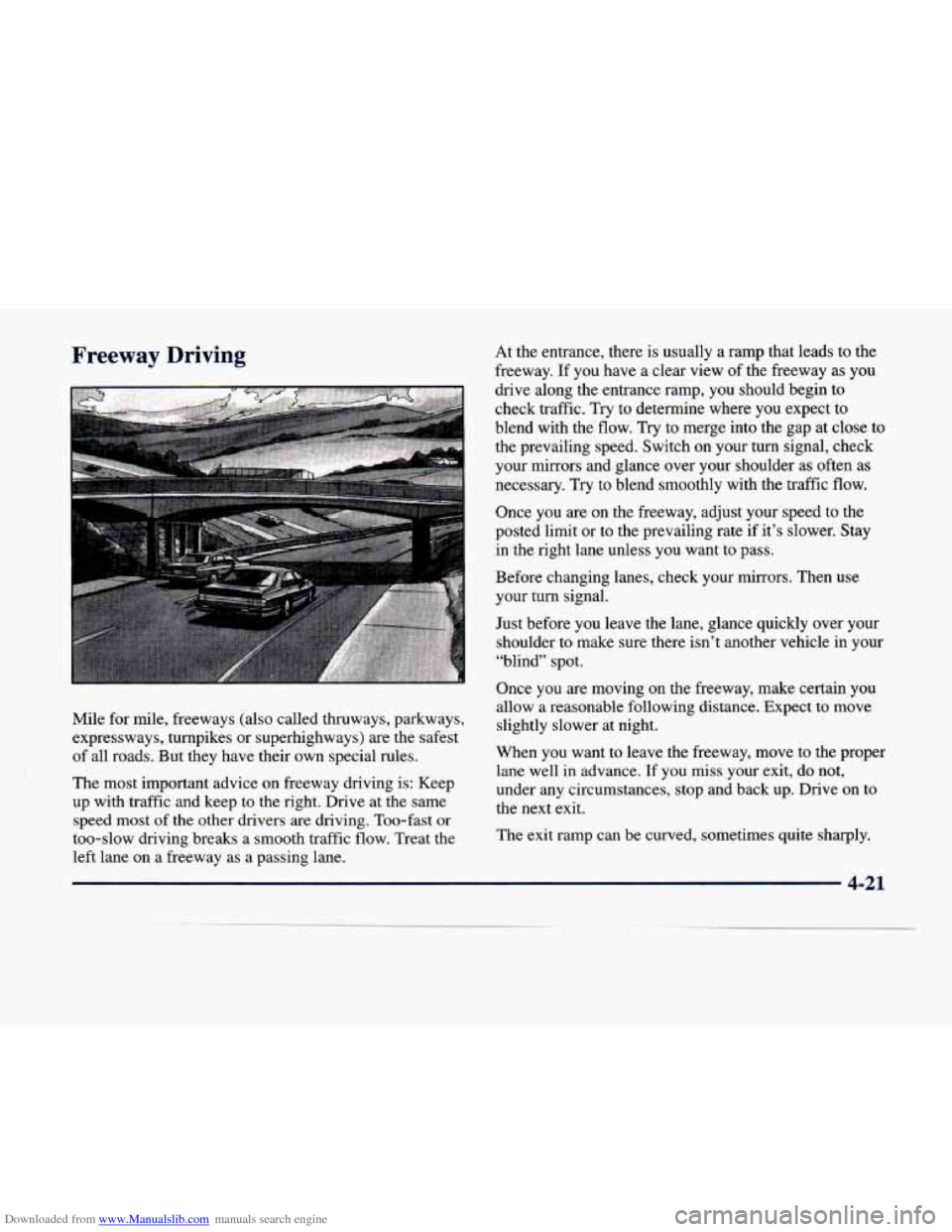
Downloaded from www.Manualslib.com manuals search engine Freeway Driving
Mile for mile, freeways (also called thruways, parkways,
expressways, turnpikes or superhighways) are the safest
of all roads. But they have their own special rules.
The most important advice on freeway driving is: Keep
up with traffic and keep to the right. Drive at the same
speed most
of the other drivers are driving. Too-fast or
too-slow driving breaks a smooth traffic flow. Treat the left lane on a freeway as a passing lane. At
the entrance, there is usually a ramp that leads to the
freeway.
If you have a clear view of the freeway as you
drive along the entrance ramp, you should begin to
check traffic. Try
to determine where you expect to
blend with the flow.
Try to merge into the gap at close to
the prevailing speed. Switch on your turn signal, check
your mirrors and glance over your shoulder
as often as
necessary. Try to blend smoothly with the traffic flow.
Once you
are on the freeway, adjust your speed to the
posted limit or to the prevailing rate if it’s slower. Stay
in the right lane unless you want to pass.
Before changing lanes, check your mirrors. Then use
your turn signal.
Just before
you leave the lane, glance quickly over your
shoulder to make sure there isn’t another vehicle in your
“blind” spot.
Once you are moving on the freeway, make certain you
allow a reasonable following distance. Expect
to move
slightly slower at night.
When you want to leave the freeway, move to the proper lane well
in advance. If you miss your exit, do not,
under any circumstances, stop and back up. Drive on to
the next exit.
The exit ramp can be curved, sometimes quite sharply.
Page 253 of 386
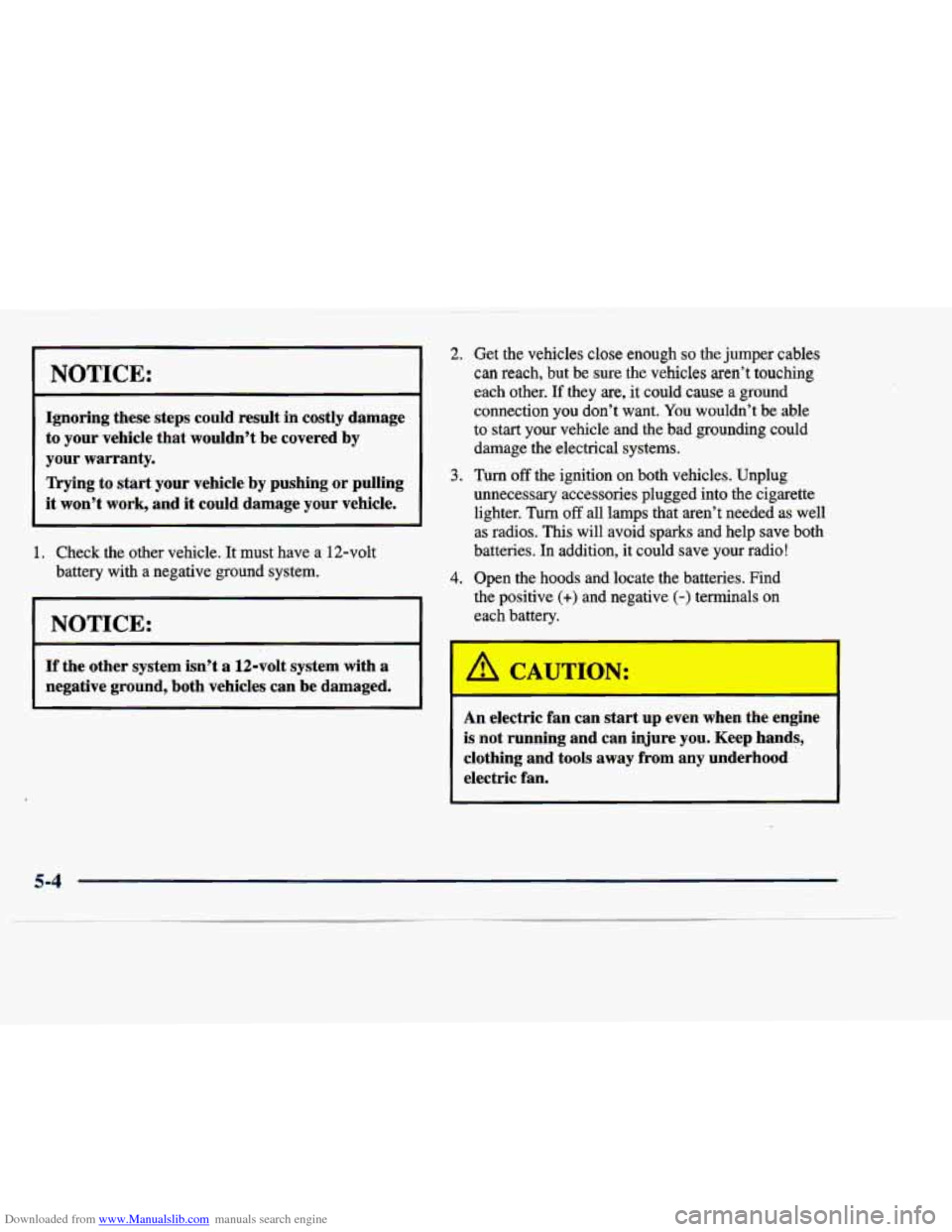
Downloaded from www.Manualslib.com manuals search engine I NOTICE:
Ignoring these steps could result in costly damage
to your vehicle that wouldn’t be covered
by
your warranty.
Trying to
start your vehicle by pushing or pulling
it won’t work, and it could damage your vehicle.
1. Check the other vehicle. It must have a 12-volt
battery with a negative ground system.
I NOTICE: I
2. Get the vehicles close enough so the jumper cables
can reach, but be sure the vehicles aren’t touching
each other. If they are, it could cause a ground
connection you don’t want.
You wouldn’,t be able
to start your vehicle and the bad grounding could
damage the electrical systems.
unnecessary accessories plugged into the cigarette
lighter.
Turn off all lamps that aren’t needed as well
as radios. This
will avoid sparks and help save both
batteries. In addition, it could save your radio!
4. Open the hoods and locate the batteries. Find
the positive
(+) and negative (-) terminals on
each battery.
3. Turn off the ignition on both vehicles. Unplug
I
If the other system isn’t a 12-volt system with a
negative ground, both vehicles can be damaged.
A CAUTION:
I I
An electric fan can start up even when the engine
is not running and can injure you. Keep hands,
clothing and tools away from any underhood
electric fan.
5-4
Page 311 of 386
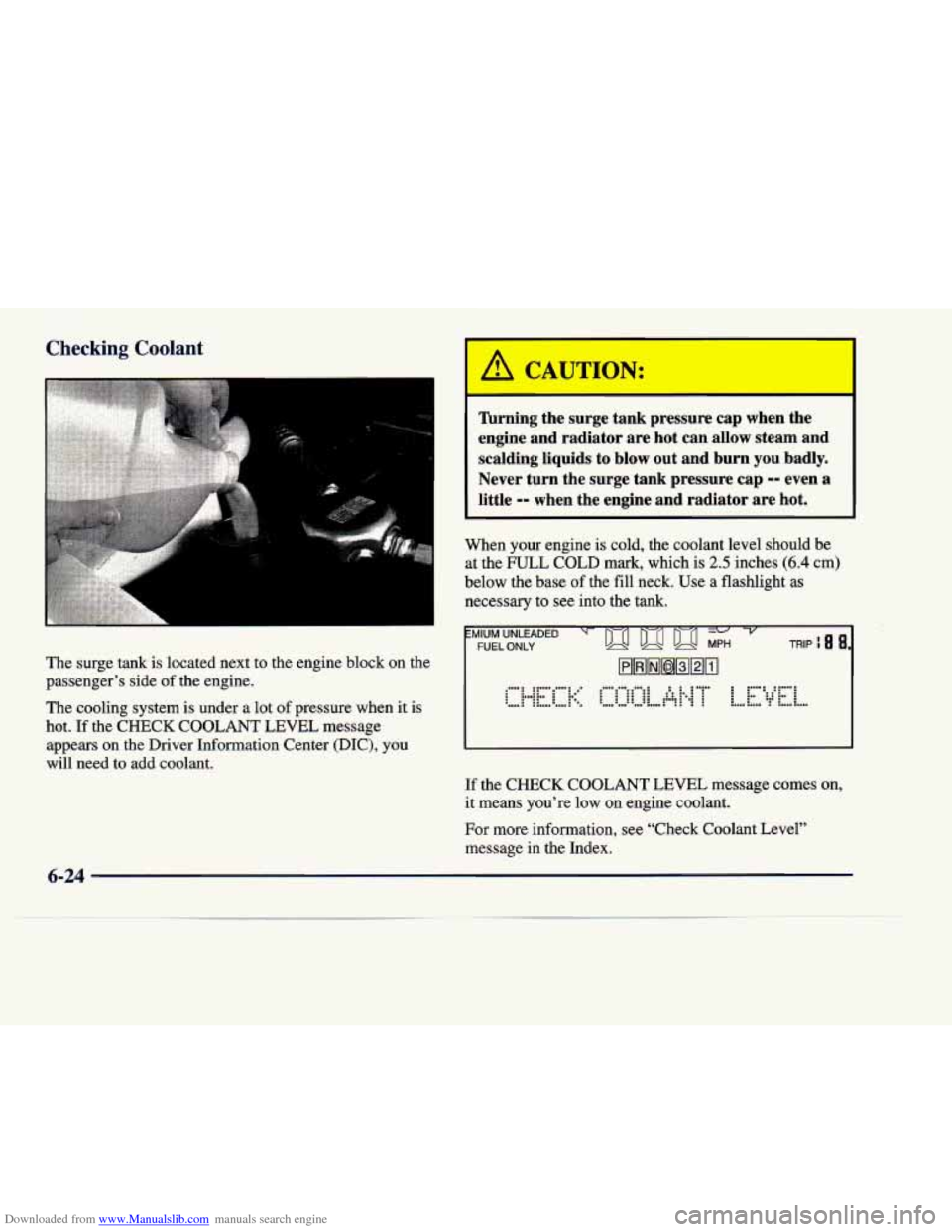
Downloaded from www.Manualslib.com manuals search engine Checking Coolant
L
The surge tank is located next to the engine block on the
passenger's side of the engine.
The cooling system is under a lot of pressure when it is
hot.
If the CHECK COOLANT LEVEL message
appears on the Driver Information Center (DIC), you
will need to add coolant.
l'brning the surge tank pressure cap when the
engine and radiator are hot can allow steam and
scalding liquids to blow
out and burn you badly.
Never turn
the surge tank pressure cap -- even a
little
-- when the engine and radiator are hot.
When your engine is cold, the coolant level should be
at the
FULL COLD mark, which is 2.5 inches (6.4 cm)
below the base
of the fill neck. Use a flashlight as
necessary to
see into the tank.
~MIUM UNLEADED -
-
FUEL ONLY IJIJ DJ DJ MK
HHrnrnrnrn
If the CHECK COOLANT LEVEL message comes on,
it means you're low on engine coolant.
For more information, see "Check Coolant Level"
message in the Index.
Page 373 of 386
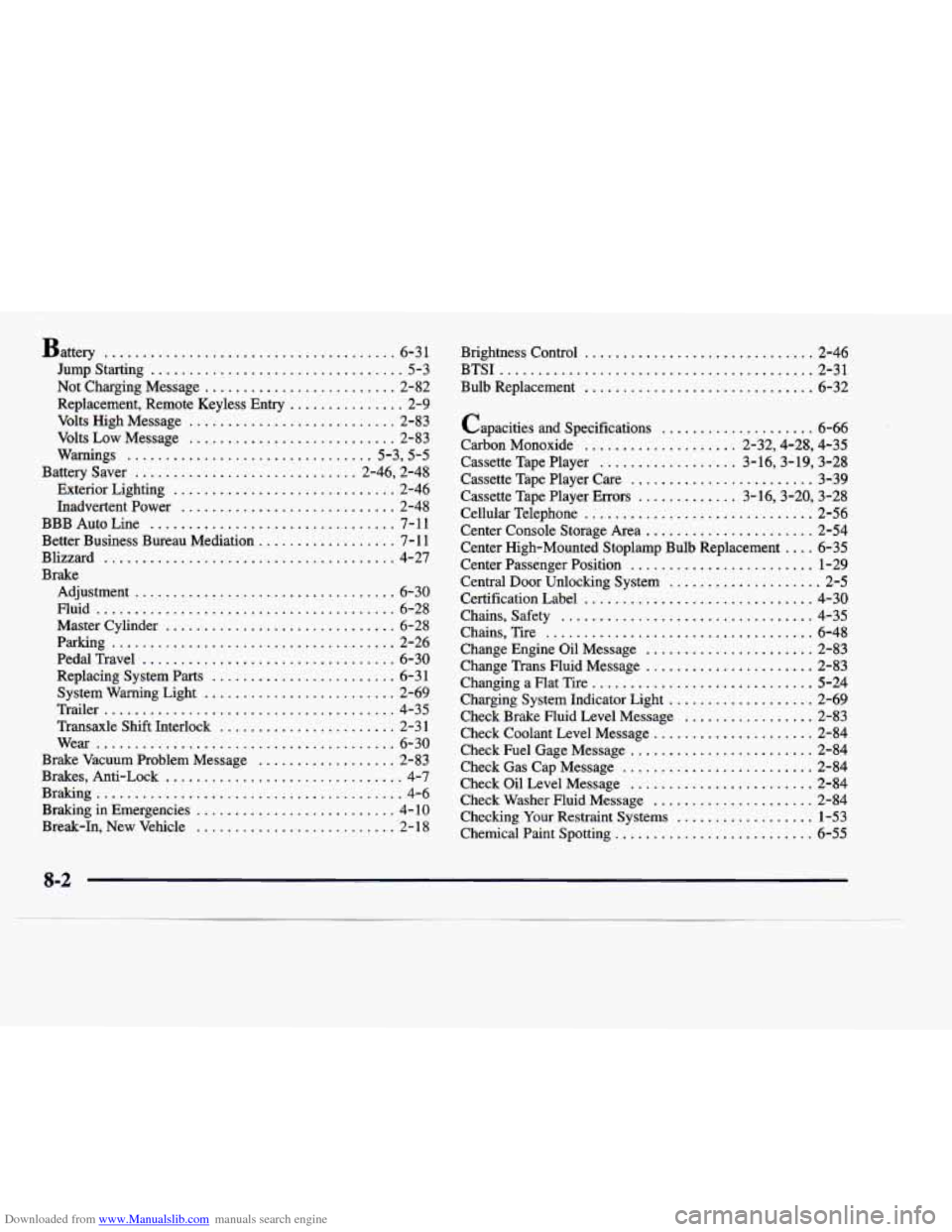
Downloaded from www.Manualslib.com manuals search engine Battery ...................................... 6.3 1
Jump Starting
................................. 5-3
Not Charging Message
......................... 2-82
Volts High Message
........................... 2-83
Volts Low Message
........................... 2-83
Warnings
................................ 5-3. 5-5
Battery Saver ............................. 2-46. 2-48
Exterior Lighting
............................. 2-46
Inadvertent Power
............................ 2-48
BBB Auto Line
................................ 7- 11
Better Business Bureau Mediation
.................. 7- 11
Blizzard
...................................... 4-27
Brake Replacement. Remote Keyless Entry
............... 2-9
Adjustment
.................................. 6-30
Fluid
....................................... 6-28
Master Cylinder
.............................. 6-28
Parking ..................................... 2-26
PedalTravel
................................. 6-30
Replacing System Parts
........................ 6-3 1
System Warning Light
......................... 2-69
Trailer
...................................... 4-35
Transaxle Shift Interlock
....................... 2-31
Wear
....................................... 6-30
Brake Vacuum Problem Message
.................. 2-83
Brakes. Anti-Lock
............................... 4-7
Braking ........................................ 4-6
Braking in Emergencies .......................... 4- 10
Break-In. New Vehicle .......................... 2-18 Brightness Control
.............................. 2-46
Bulb Replacement
.............................. 6-32
BTSI
......................................... 2-31
Capacities and Specifications
.................... 6-66
Carbon Monoxide
.................... 2.32.4.28. 4.35
Cassette Tape Player
.................. 3.16.3.19. 3.28
Cassette Tape Player Care
........................ 3-39
Cellular Telephone
.............................. 2-56
Center Console Storage Area
...................... 2-54
Center Passenger Position
........................ 1-29
Central Door Unlocking System
.................... 2-5
Chains. Safety
................................. 4-35
Change Engine Oil Message
...................... 2-83
Change Trans Fluid Message
...................... 2-83
Changing a Flat Tire
............................. 5-24
Charging System Indicator Light
................... 2-69
Check Brake Fluid Level Message
................. 2-83
Check Coolant Level Message
..................... 2-84
Check Fuel Gage Message
........................ 2-84
Check Gas Cap Message
......................... 2-84
Check Oil Level Message
........................ 2-84
Check Washer Fluid Message
..................... 2-84
Checking Your Restraint Systems
.................. 1-53
Chemical Paint Spotting
.......................... 6-55
Cassette Tape Player Errors
............. 3.16.3.20.
3-28
Center High-Mounted Stoplamp Bulb Replacement
.... 6-35
Certification Label
.............................. 4-30
Chains. Tire
................................... 6-48
8-2